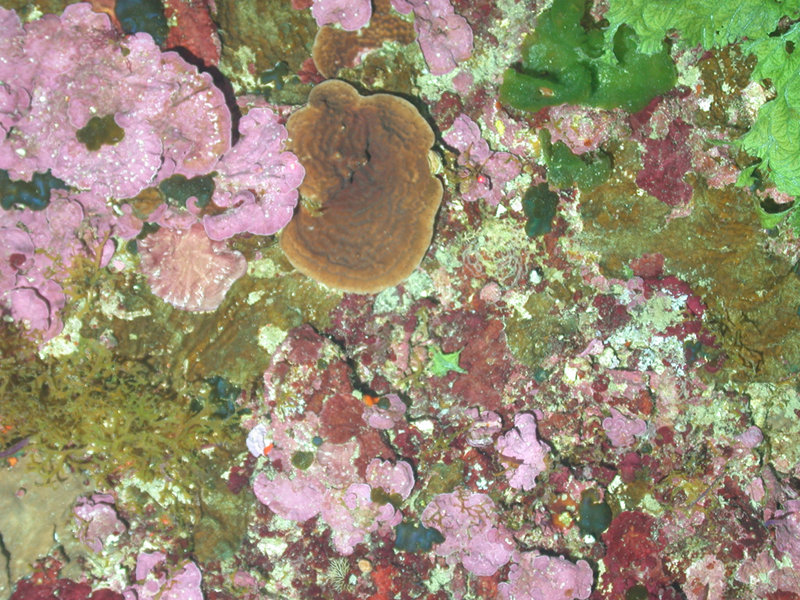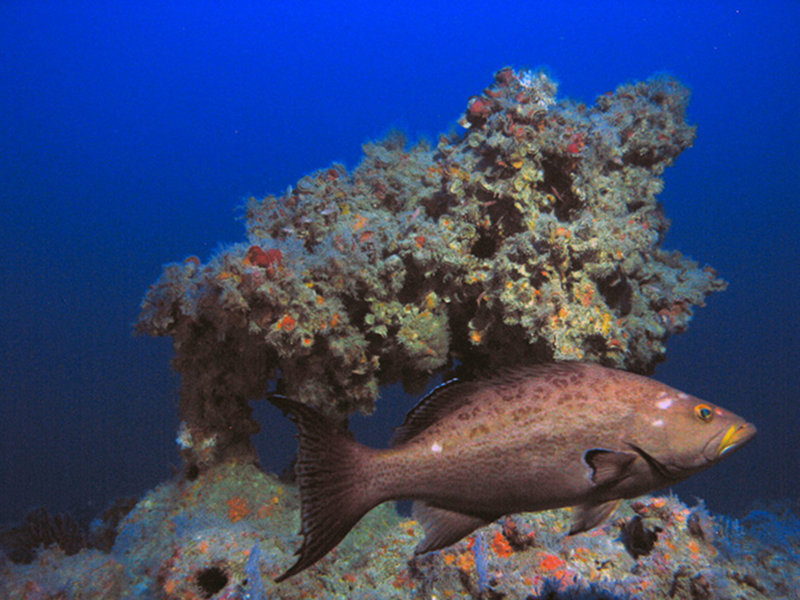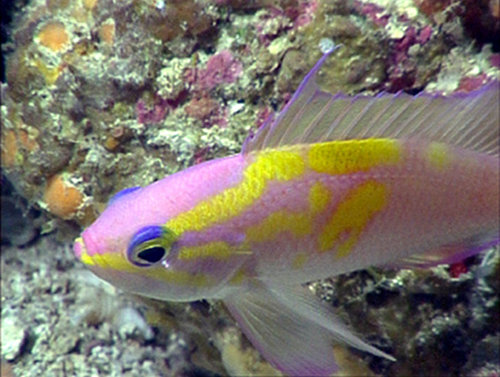
Kimberly Puglise, Oceanographer and Project Federal Program Officer - NOAA’s National Centers for Coastal Ocean Science

Figure 2. The dominant communities providing structural habitat at Pulley Ridge are coralline algae (thin pink plates) and hard coral (brown plates are Agaricia sp.). Image courtesy of John Reed using the University of Connecticut’s Kraken remotely operated vehicle. Download larger version (jpg, 1.2 MB).
The term “coral” conjures up visions of warm, tropical waters, or, as of late, the cold dark depths of the ocean where not a ray of sunlight penetrates. Found between these two visions is a relatively unknown and poorly understood depth realm referred to as the mesophotic zone – ‘meso’ for middle and ‘photic’ for light. Mesophotic coral ecosystems are characterized by the presence of light-dependent corals and associated communities typically found at depths ranging from 30-40 m and extending to over 100 m in the Gulf of Mexico (Figure 1). The dominant communities providing structural habitat in the mesophotic zone can be comprised of coral, sponge, and algal species (Figure 2).

Figure 1. Mesophotic coral ecosystems can be found from 30-100 m in the eastern Gulf of Mexico. Pictured is a scamp grouper at 95 m off the Dry Tortugas. Image courtesy of Cooperative Institute for Exploration, Research & Technology. Download image (jpg, 128 KB).
Little is known or understood about mesophotic coral ecosystems. Investigations into the mesophotic zone have been hampered by technology. The upper limit of mesophotic coral ecosystems happens to coincide with the diving limit for conventional scuba diving (30-40 m), and is too shallow and costly for most deep-diving technologies (e.g., remotely operated vehicles and submersibles) to operate. However, advances in undersea technologies, such as, technical diving and shallow remotely operated vehicles (Figure 3), in the past decade have begun to make investigating these ecosystems possible.

Figure 3. Remotely operated vehicles or ROVs, such as the University of North Carolina at Wilminton’s Super Phantom S2 with a maximum diving depth of 300 m, capable of maneuvering in shallow water make it possible for us to study mesophotic reefs. Image courtesy of University of North Carolina at Wilmington. Download image (jpg, 25 KB).
In an era of significant coastal ocean changes and documented human impacts on shallow coral reefs, it is important to understand the value and role of mesophotic coral ecosystems in tropical and subtropical ecosystems. Mesophotic coral ecosystems may be regarded as extensions of shallow coral ecosystems including sharing common species. As a result, scientists have hypothesized that mesophotic coral ecosystems may serve as potential sources to reseed or replenish degraded shallow-water coral reef species.

Figure 4. A close-up of the anthiid fish known as the roughtongue bass, Protonogrammus martinicensis, is only found at depths greater than 60 m in Florida and the Gulf of Mexico. Image courtesy of Cooperative Institute for Exploration, Research & Technology. Download image (jpg, 65 KB).
Mesophotic coral ecosystems may be colonized by a number of species that are only found within this depth range (Figure 4) or geographical location. These species are known as endemic species. Endemic species are especially vulnerable to disturbances from human activities such as fishing and risk extinction if they are overexploited.
Mesophotic coral ecosystems may also serve as essential fish habitat for economically- and ecologically-important species. Essential fish habitat is those waters and substrate necessary to fish for spawning, breeding, feeding, or growth to maturity. In addition, similar to shallower coral ecosystems, mesophotic coral ecosystems contain organisms with specialized defenses to ward off predators and microbial infections. These specialized defenses often yield ‘novel’ compounds that can be used to develop natural products from the sea (e.g., cancer drugs and skin care products) that benefit to mankind.
Since mesophotic coral ecosystems are extensions of shallow-water reefs, they are subject to many of the same threats faced by shallower coral ecosystems, such as climate change, fishing, pollution, invasive species, and coastal uses (e.g., dredging and anchoring). The degree and extent each threat poses to these ecosystems is unknown and needs to be evaluated.
Mesophotic corals are adapted to live in low-light conditions and require sunlight for survival. Thus, anything that limits light penetration can be very harmful. For example, activities such as dredging or sediment runoff from the land can cause the water to become murky or turbid, preventing sunlight from reaching this ecosystem.
Increased nutrients may also pose a problem to these ecosystems. At mesophotic depths, there are less plant eating species (herbivores) compared to shallower depths. Therefore, if an algal bloom (a rapid increase in the algal population) is triggered by increased nutrients, there will not be enough species present to reduce the impact of the algal bloom.
The impacts from overfishing are well-documented for shallow coral ecosystems near populated areas. These impacts include the disappearance of large predators (e.g., groupers and snappers) and important herbivores (e.g., parrotfish) from near shore areas, as well as decreases to the size and abundance of fishes, invertebrates and corals. As shallower, near shore areas become overexploited, fishing is spreading to deeper areas and more remote locations. The concern for mesophotic coral ecosystems is that since many of these areas are unprotected, they may be deleteriously impacted.